Hi Claire,
Your blog on Kew lichens is fascinating
I collected some specimens from Hardwick in Derbyshire on Wednesday, as I want to brush up on lichens for our Fungi (and Lichen) Survey of the Longshaw Estate. I’ve recently examined the fungi collection held by Sheffield Museum, catalogued them, and put a few disconnected caps and stems together. Mostly they’re from the 1960’s, with many from Longshaw. I went to my first fungus foray there in 1969, so it was quite moving to see some of the preserved specimens with labels written by the leader at that time, Terry Bottomley, as well as some of the water colour paintings he made. The specimens are mostly freeze-dried I think, and some are spectacular, such as the Glistening Inkcaps. These would have turned to ink overnight, but have been perfectly preseved for half a century. I examined a small bit of Orange Peel Fungus, which was almost perfect microscopically, with oil drops in the spores and other structures such as asci and paraphyses more or less intact. But the spores didn’t germinate!
There are 82 collections of freeze-dried or air-dried fungi at Sheffield Museum, representing about 65 species, 40 from named sites, 57 with a museum reference number. The reference numbers may allow us to get more data on the specimens. A few labels were with the wrong specimen, and a few stalks and caps had been mixed up. Mostly the identifications looked OK. After half a century the collection was quite impressive.
We’re keeping a herbarium of fungi (and lichens now) from the Longshaw Estate. These are air-dried, placed in sealed plastic packets and then kept in a freezer for several months. After that they should, according to the Museum curator, be OK for a good while.
Good luck with your project and with the jobs threat at Kew. I’ve signed the petition.
Here are some pictures of the Sheffield Museum Fungi Collection:
Part of the collection.
One label describes the preservation process.
Glistening Inkcaps – Coprinellus micaceus, miraculously preserved – normally they would deliquesce to a pool of black Ink after a few hours when collected.
The fragile PurpleBrittlestem – Russula atropurpurea still beautifully coloured after 50 years or so.
The Yellow Swamp Brittlegill, still brilliant yellow, from 1966.
One of the many collections from the Longshaw Estate is the Herald of Winter, Hygrophorus hypothejus. Longshaw is a special place for Sheffield as it was bought by public subscriptions, mostly by Sheffield folk, in the late 1920’s and mid 1930’s, to save it from urban development. It has the best fungi of the Sheffield area. At the moment some of the most unspoiled parts are threatened by major rail developments along the Sheffield-Manchester line. We’ve been collecting fungi and other natural history records there since December, when we first heard of the plans.
The Orange Peel Fungus, now renamed as Aleuria aurantia. Like lichens, many of the names from the specimens (1964-70) have been changed. The specimen has faded to buff from its original brilliant orange, so confirmation by microscopy would be useful.
The curator allowed me to take a small fragment of the faded Orange Peel Fungus. Although the orange pigment had faded, the microscopy was impressive – even showing the oil-drops in the spores.
The reticulated ornamentation and size confirms the specimen as Aleuria aurantia (formally Peziza aurantia).
Best regards,
Steve Clements, Longshaw Fungi Recorder

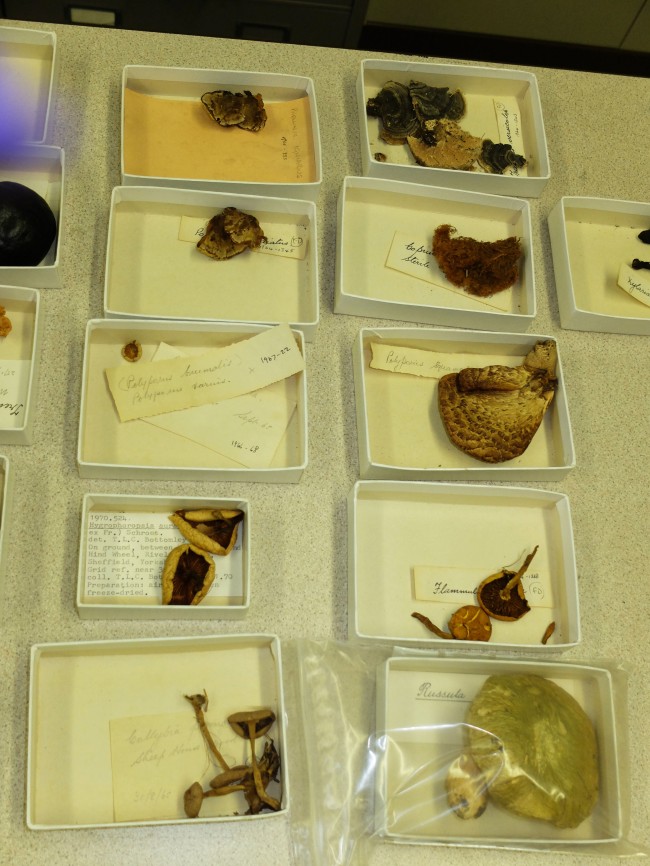
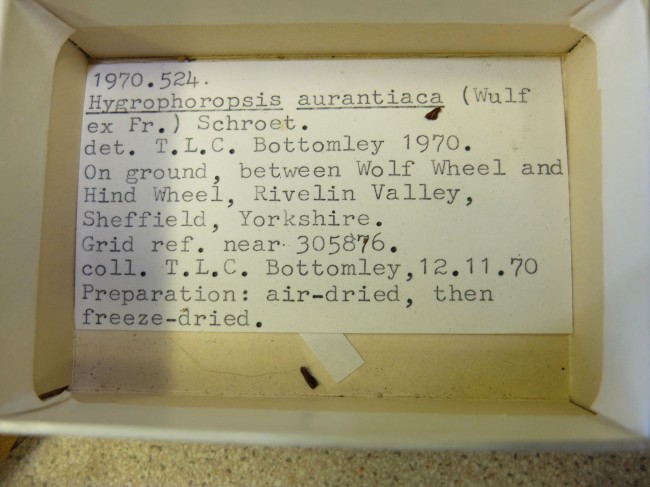
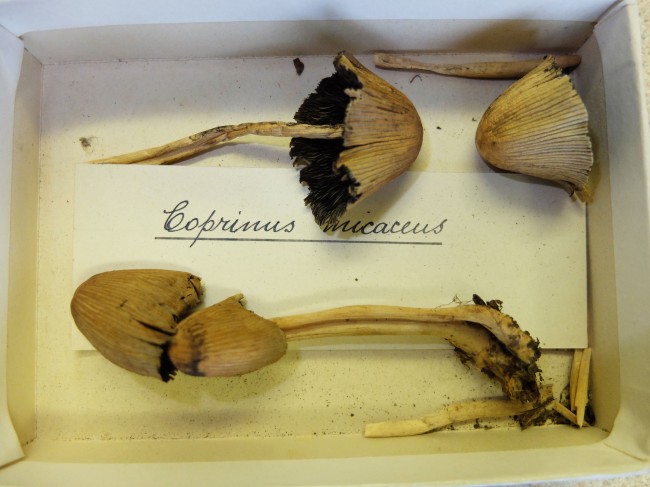
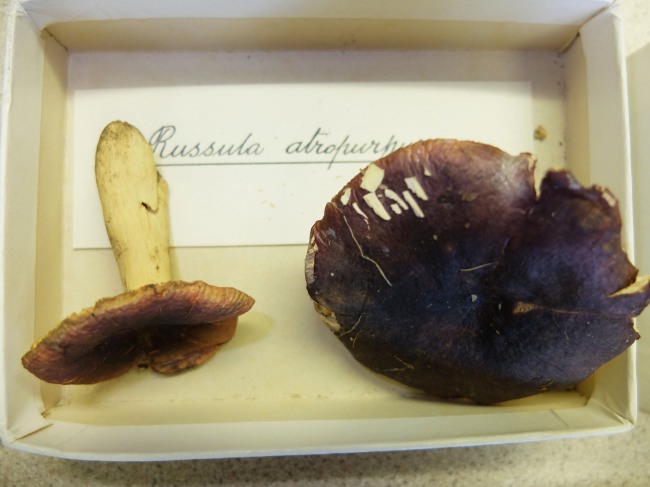
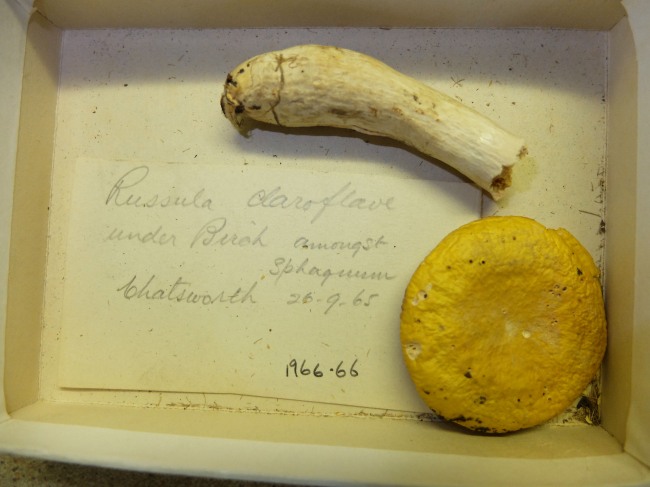
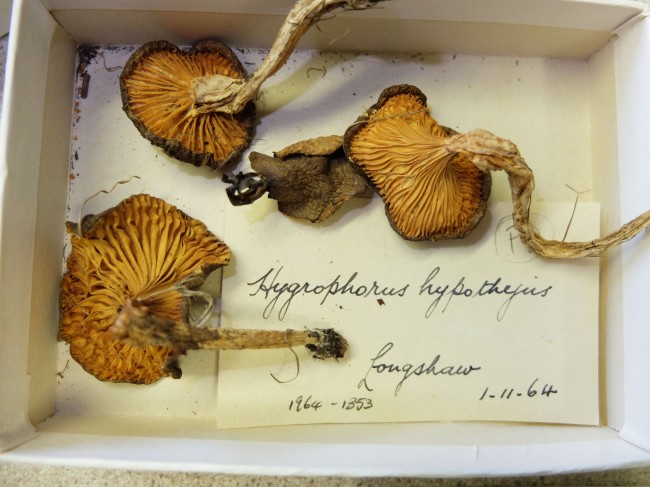
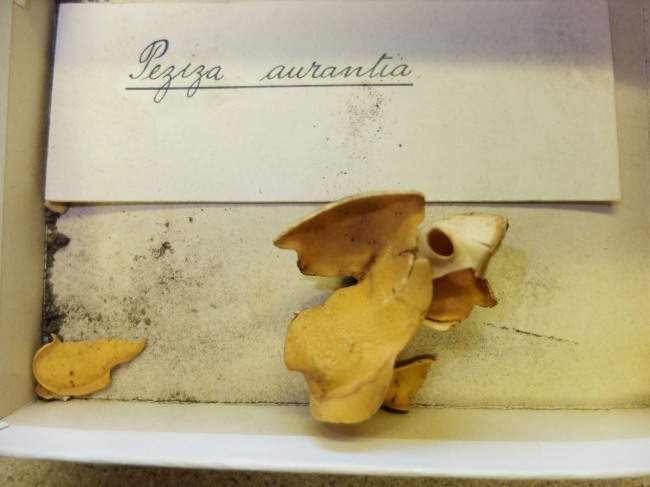
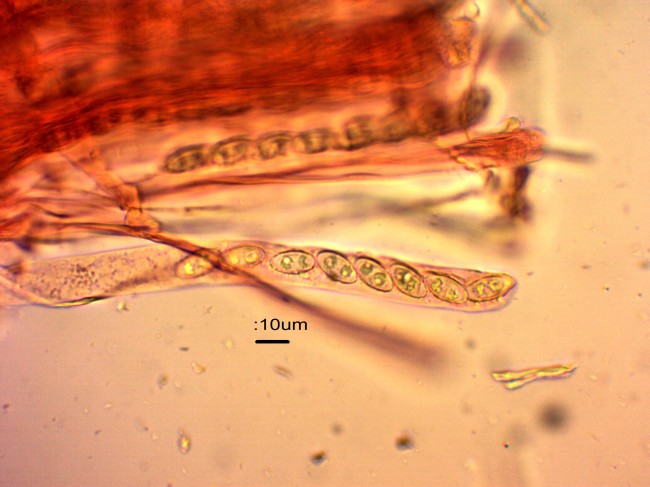
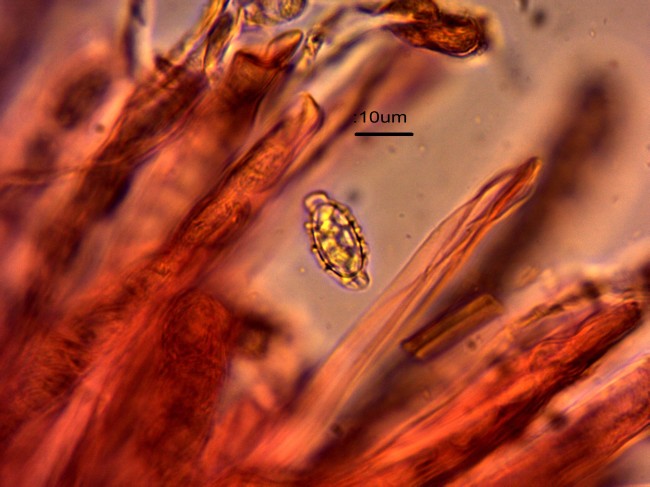
Claire follows us on Twitter too.
Hi Steve
This is fascinating reading – very interesting about the collections at Sheffield and the preservation techniques you describe. It is amazing how well preserved they are – presumably down to some very prompt action after collection, and fantastic that there is so much detailed information still available in the specimens. Great to have that data for comparison with your collection. From a curatorial point of view, will you be able to have any environmental control for your Longshaw collection once its dried and prepared?
Knowing the area around Longshaw and Padley from my young years in Hathersage, I’m enjoying following the blog and think the work you are doing there is fantastic. I heard about the Sorby group at a DWT talk on waxcaps by Rob Foster.
Claire Miles
Project Collections Information Officer, Museum of Science & Industry.
Honorary Curatorial Associate, Manchester Museum
Hi Claire,
Long term we’ll give our herbarium to Sheffield Museum I would expect – but it’s chiefly as a reference to check identifications that we’re keeping it. We have dozens of specimens already on which we could do further microscopy. As we’re thinking in terms of an initial 5 years at least, then it’s going to be a big collection. John Leach and I are both keeping herbaria. After treatment in the freezer for a few months my specimens will be kept in sealed plastic bags and stored in cardboard folders up in my attic.Seeing how you are sorting the lichens is giving me some good ideas. We may try to assemble a range of typical fungi specimens specifically for the museum, but I’d first want to be sufficiently reassured that they would be accessible to future researchers – it took me a number of applications over several years to get access to the Sheffield Collection; it was only a meeting with the curator which sorted things. This might have been because of the drastic re-structuring of the “old-fashioned” Weston Park Museum which I had known all my life.I took my very first photo there with a camera obtained by saving cereal packet tops – it was a polar bear. From its extensive displays I learned archaeology, geology and all manner of natural history etc. Even in my last years as a Biomedical Scientist working at the Royal Hallamshire Hospital nearby shortly before I retired I’d pop out at lunch time to look at the local Geology displays. Sadly it has mostly become an empty shell, agreed by most of us at a recent meeting with the curator to be little more than a creche. There is talk of establishing a display for adults! My wife Liz and I visited the lovely museum at Buxton recently – a place where adults and children can really share a museum experience.
At the moment most of the Shefffield collections are kept in a secret warehouse. This is where the fungi are. My next step is to see if I can retrieve information from the museum reference numbers for the fungi which lack details.
We’re off to Longshaw tomorrow – I’ll be specifically looking for lichens this time.
If you would like to go on our Longshaw emailing list then you could see what we’re up to – I just sent round a summary of the fungal finds for the first 6 months, the next task is to add lichens to the lists.
Cheers,
Steve
Hi Steve
Sadly, I can appreciate the difficulty of accessing collections from both the visitor and curatorial point of view. With limited resources (and sometimes the will from above), it’s frustrating for museum staff and visitors alike that museums have to balance priorities to be able to maintain collections (which often have to be away from the point of public access because of lack of space/environmental control), along with the staff/time to provide all the supervised access for research that people would like. Most curators are very eager to have the collections used (that is the point, after all) but control of that is resource heavy, particularly one-to-one visits. Getting more people to visit natural history collections has to be a good thing in promoting engagement with nature, making people aware that the collections are there and hopefully generate funding/income. I agree that for a small museum, Buxton does a great job in involving the local community and I like that there’s always something different to see.
You’ve inspired me to enquire into the fungi collection in the Herbarium at Manchester Museum and see how that’s curated, when I can schedule it. (I concentrated on the botanical collections last year and the week at the NHM working with lichens was an introduction into that area for me.) There are about 20,000 fungi specimens at Manchester according to the website.
Looking on the NatSCA website for information on preserving fungi reminded me about NatSCA’s ‘Natural History near you’ initiative which you might be aware of. NatSCA is compiling a database of all UK natural history collections, no matter how small. The results are viewable on an interactive map. If not aware, and interested in adding information, the link is http://www.natsca.org/NHNearYou .
Regards
Claire
Reblogged this on The Diary of a Natural History Trainee Curator.